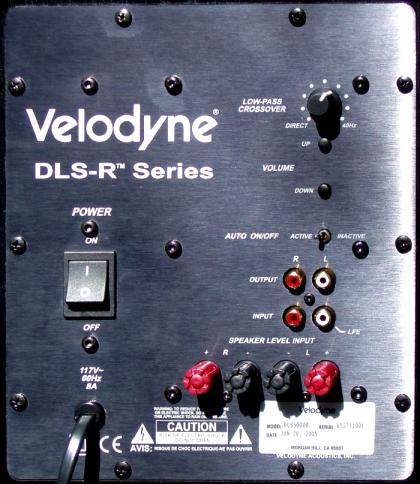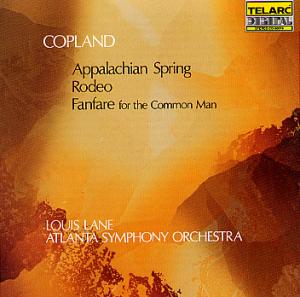Velodyne DLS-5000R 15" Subwoofer with Built-In Digital EQ Part I September, 2005 John E. Johnson, Jr.
|
Introduction
I can remember when Velodyne only had three subwoofer models.
Boy, have times changed. Like other successful and growing companies, Velodyne has since expanded their product line to include almost two dozen models.
Their first subs were a few thousand dollars. Their current lines still include the big bucks subs, but also, very affordable products too, such as the DLS-5000R, which is a 15" sub, street priced at $799.
How do they do it? Design them here, and have them built in China. It's called OEM. Everyone seems to be doing it now, and we as consumers, benefit.
So, we are talking about a 15" driver with a 4.4 pound magnet, 600 watts of amplification, and digital EQ. All for less than $800. Can this be real, and does it perform?
Let's see.
The Design
There is not much really to say about the driver, other than it is big, with a heavy magnet. The amplifier is rated at 600 watts RMS, which is big too. Much bigger than subwoofer amplifiers of a few years ago. The secret is in using digital switching, which results in big power in a small footprint, and also, lower cost.
The story with this subwoofer is in the digital EQ. In fact, the low-pass and high-pass functions of this subwoofer series are digital. But, the digital EQ is something that lets you adjust the "sound" of the subwoofer to your musical tastes. For movies, you want maximum punch, while for jazz and classical, you want maximum accuracy.
You may remember when Home Theater first came on the scene. Manufacturers spoke of having speakers that were suited to home theater vs. suited for music. Well, digital EQ in powered subwoofers lets you have both in one product.
For my own system, I use EQ with two of the subwoofers (I
have four subs). It comes from an old AudioControl product called a Phase
Coupled Activator (PCA). The PCA generates sub-harmonics, meaning that if
there is a 36 Hz signal in the movie sound track, the PCA generates an 18 Hz
sub-harmonic. I use it only with movies, and turn it off for music, because
with an explosion, it sounds great, but for a string bass, it sounds
strange. I would never part with this little toy, but it is analog, and
being in the signal path, it does create some additional noise.
I also use the digital EQ that is built-into the Velodyne DD-18, for adjusting the room response.
Although the DLS-5000R does not let you flatten your room response, it does let you adjust the way the subwoofer sounds, not by adding sub-harmonics, but by changing the overall response to produce certain effects. For movies, you can have an intense bass, while for jazz and classical music, it will be more accurate, i.e., more subtle.
The EQ modes are preset, and you get to them by using the supplied remote control, which also lets you adjust the volume, the phase (four settings as shown on the right), mute the subwoofer, turn the indicator light on the front of the subwoofer off, and activate Night mode, which quiets things down.
When you select one of the EQ modes, or the phase, the light on the front of the subwoofer blinks once, twice, three times, or four times, depending on the mode or phase. This is to confirm that the subwoofer has received the remote signal and has set the mode or phase.
With each of the four EQ modes, the subsonic filter frequency (24 Hz - 34 Hz), EQ frequency (37 Hz - 62 Hz), EQ level (up to 4 dB), and volume differential (up to 8 dB) is changed.
The amplifier panel is shown below. At the top right is the low-pass crossover adjustment knob, which lets you set the crossover as low as 40 Hz. At the other end is the Direct setting, which lets in all frequencies up to 200 Hz.
 Below the crossover knob are two push-buttons, which are
for volume control. One is for Up and the other is for Down. You can also
control the volume with the remote.
Below the crossover knob are two push-buttons, which are
for volume control. One is for Up and the other is for Down. You can also
control the volume with the remote.
Then comes the Auto On/Off, which senses an input signal. There are line-level inputs and outputs, with the outputs having a high-pass signal. Speaker-level inputs are also present. The main power on/off toggle is on the left, so actually, the push button on/off on the remote control is a standby switch. The AC cord is non-grounded and is non-detachable.
The Sound
I tested the DLS-5000R in one of our home theater labs, using the Yamaha universal DVD player, McCormack CD player, Lexicon MC-12 SSP, BAT VK-5i preamplifier, BAT VK-500 power amplifier, McIntosh MC-602 power amplifier, and McIntosh MC-1201 power amplifiers. Speakers were Carver Amazings (ribbon speakers) and Final Acoustics ESLs. Cables were Nordost.
Well, there is nothing like a big driver, a powerful
amplifier, and a big enclosure. The DLS-5000R has all of those things, and
it showed. I  played my sub killer CDs and DVDs, but nothing could
faze it.
I simply could not get it to bottom out. Of course, it helps that Velodyne
has power management built-in, so that it does not over-drive, but I usually
can get subwoofers to hit the wall somewhere along the line.
played my sub killer CDs and DVDs, but nothing could
faze it.
I simply could not get it to bottom out. Of course, it helps that Velodyne
has power management built-in, so that it does not over-drive, but I usually
can get subwoofers to hit the wall somewhere along the line.
My favorite for this kind of test is the Copland "Fanfare for the Common Man" (Telarc). The most amazing thing about this disc is that it is old. One of the early CDs as a matter of fact. It has no dynamic compression that plagues some modern CDs (they do that so that consumers won't blow up their hi-fi systems). But, the Copland CD was produced with full dynamics, and there are some bass drum thuds that stress any subwoofer and power amplifier. The McIntosh MC-1201s were outputting 1,000 watts per channel into the Carvers, and the Velodyne kept up with them, adding the deep bass, below 50 Hz, that gets lost from the Carvers due to their bipolar woofer configuration.
 I
used the Jazz/Classical EQ mode for all the classical music, as it sounded
very tight and accurate. When I switched over to some rock music, such as
Mary-Chapin Carpenter's Come On Come On, I changed to the R&B/Rock mode,
where the bass seemed to have more kick to it. However, being a purist, I
went back to the Jazz/Classical mode, and that is where it stayed.
I
used the Jazz/Classical EQ mode for all the classical music, as it sounded
very tight and accurate. When I switched over to some rock music, such as
Mary-Chapin Carpenter's Come On Come On, I changed to the R&B/Rock mode,
where the bass seemed to have more kick to it. However, being a purist, I
went back to the Jazz/Classical mode, and that is where it stayed.
I even preferred the Jazz/Classical mode for movies, because it just sounded more natural to me. Of course, most of the deep sound effects in movies are synthesized digitally (such as in one of my favorite subwoofer test DVDs, Daylight), but there is just something about tight bass that I prefer, even with explosions. The point is that you have a choice with this subwoofer.
One of the bench test graphs below shows the room response for all of the modes, and you can see that the response changes, with more or less at certain frequencies. Digital EQ is a great addition to subwoofing, but it is also something we will see more and more of in SSPs and receivers, for EQ at the remaining part of the audible spectrum. Since it is all performed digitally, we won't get the phase shift that normally accompanies EQ in the analog domain.
|
© Copyright 2005 Secrets of Home Theater & High Fidelity |




